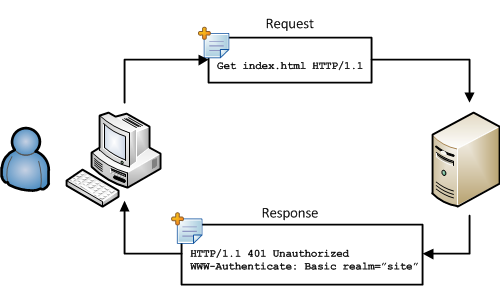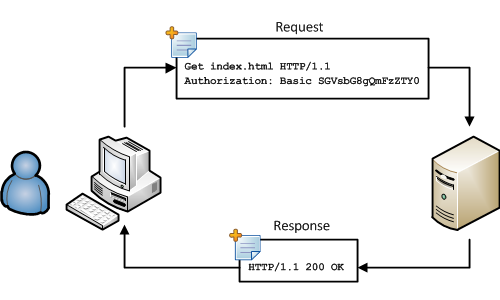Contents
Introduction
This article explains a method to secure a REST based service using Basic Authentication. The service itself is implemented using Microsoft Windows Communication Foundation. The authentication of the credentials should be possible against any type of backend. For example, authenticate against an Active Directory, a custom file, or a database. Basic Authentication is a standard available in combination with WCF and IIS, but the downside of this is that authentication is only possible against an Active Directory.
Although Basic Authentication is a method to secure a web site or service, the authentication mechanism itself is not secure. The user name and password are sent Base64 encoded over the internet. To make this more secure, the server should offer the service using HTTPS. HTTPS secures the channel so that the Base64 encoded user name and password cannot be decrypted. An alternative to Basic Authentication is Digest Authentication which is also possible with WCF REST. I created a separate article on CodeProject that describes Digest Authentication on a WCF RESTService.
This article and the provided source code can be used in two ways. First, just download the code, go down to theUsing the code section, and implement your WCF service using Basic Authentication. Second, you can use the article to learn what exactly is Basic Authentication and how can WCF REST be extended.
Basic Authentication
Basic Authentication is a standard protocol defined within HTTP 1.0 that defines an authentication scheme. In this scheme, the client must authenticate itself with a user-ID and password. Basic Authentication is described in RFC 2617. When a client requests a resource from a site that is protected using Basic Authentication, the server returns a 401 "Not authorized" response. Inside this response, the server has added an indication that the site is protected using Basic Authentication. The server adds WWW-Authenticate: Basic realm="site" to the header of the response;Basic indicates that the authentication scheme is Basic Authentication, and realm is a string that indicates which part of the site is protected. It has no further usage in the actual authentication mechanism itself. An internet browser generates a dialog based on this response message. This dialog shows the realm and allows a user to enter a user name and password.


When a user enters the user name and password, the client resends the request but adds "Authorization: Basic SGVsbG8gQmFzZTY0" to the header of the request. The characters after Basic are the user name and password, separated by a single colon ":" in a Base64 encoded string. The server decodes the string, extracts the credentials, and validates them against the back-end. When the credentials are correctly validated, the server returns the requested content to the client.

Extending WCF REST
To be able to integrate Basic Authentication with WCF REST, we have to extend the functionality of the WCFframework. The extension is divided into three steps:
- Find the extension point to apply behavior to all operations of the service
- Create a custom authentication mechanism based on existing standards
- Create a security context based on the given credentials
Each of these steps is described in this article.
Finding the extension point, RequestInterceptor
WCF REST is part of the WCF REST Starter Kit. Unlike standard WCF, the WCF Starter Kit provides a simple way to apply the behaviour to all server operations. Adding this behavior to normal WCF can get fairly complex. WCF RESTuses Request Interceptors. Request Interceptors shield you from the more complex extensibility points. Request Interceptors are executed at the WCF channel level, and enable you to interpret the incoming request and generate an appropriate response.
 Collapse | Copy Code
Collapse | Copy Codepublic class MyRequestInterceptor : RequestInterceptor
{
public override void ProcessRequest(ref RequestContext requestContext)
{
}
}
By deriving a new class from the RequestInterceptor base class, you create a custom request interceptor. The method ProcessRequest is executed for every request that arrives at the service. Inside this method, you can read the header of the request and decode the Base64 encoded string if it is present. If it is not present, a response is generated that includes WWW-Authenticate: Basic realm="site" in the header. If it is present, we create a newsecurity context and set the credentials on this context.
Linking the custom RequestInterceptor to the service
The RequestInterceptor can be linked to the service by creating a custom ServiceHostFactory. TheServiceHostFactory is responsible for providing instances of ServiceHost in managed hosting environments. By managed hosting environments I mean services that are hosted within IIS. The CreateServiceHost method of theServiceHostFactory creates a new WebServiceHost and adds the new RequestInceptor to theInterceptors collection.
 Collapse | Copy Code
Collapse | Copy Codepublic class BasicAuthenticationHostFactory : ServiceHostFactory
{
protected override ServiceHost CreateServiceHost(Type serviceType,
Uri[] baseAddresses)
{
var serviceHost = new WebServiceHost2(serviceType, true, baseAddresses);
serviceHost.Interceptors.Add(RequestInterceptorFactory.Create(
"DataWebService", new CustomMembershipProvider()));
return serviceHost;
}
}
This new ServiceHostFactory is linked to the service through the markup file (.svc) of the service. Inside the markup, you add the host factory of the service.
 Collapse | Copy Code
Collapse | Copy CodeFactory="WCFServer.BasicAuthenticationHostFactory"
Custom authentication method, creating a custom MembershipProvider
The provided source code uses a MembershipProvider to actually perform the authentication of the credentials of the client. You can write your own membership provider by deriving from MembershipProvider. The only method that needs to be implemented is the ValidateUser method. This is the method the code uses to validate the user. This custom MembershipProvider is linked to the RequestInterceptor in the CreateServiceHost method of the ServiceHostFactory.
 Collapse | Copy Code
Collapse | Copy Codepublic class CustomMembershipProvider : MembershipProvider
{
public override bool ValidateUser(string username, string password)
{
return false;
}
.....
}
Creating a security context
After we have authenticated the incoming request, we have to create and set the security context. This enables the usage of the client credentials inside a service method. WCF uses the thread local ServiceSecurityContext for this. After the request has been authenticated, a new ServiceSecurityContext is created and added to the incoming request. See the code below from the provided source code that creates a new ServiceSecurityContext.
 Collapse | Copy Code
Collapse | Copy Codeinternal ServiceSecurityContext Create(Credentials credentials)
{
var authorizationPolicies = new List<iauthorizationpolicy>();
authorizationPolicies.Add(authorizationPolicyFactory.Create(credentials));
return new ServiceSecurityContext(authorizationPolicies.AsReadOnly());
}
This enables to retrieve the user name of a service method as follows:
 Collapse | Copy Code
Collapse | Copy Code[OperationContract]
public string DoWork()
{
string name = ServiceSecurityContext.Current.PrimaryIdentity.Name;
return "Hello " + name;
}
Using the code
If you want to secure your own WCF REST service with Basic Authentication using the provided source code, you need to execute the following steps:
- Add a reference to the BasicAuthenticationUsingWCF assembly
- Create a new Membership Provider derived from
MembershipProvider
- Implement the
ValidateUser method against your back-end security storage
- Create a custom BasicAuthenticationHostFactory, see the example in the provided source code
- Add the new BasciAuthenticationHostFactory to the markup of the .svc file
Points of interest
Although Basic Authentication is a method to secure a web site or service, the authentication mechanism itself is not secure. The user name and password are sent Base64 encoded over the internet. To make this more secure, the server should offer the service using HTTPS. HTTPS secures the channel so that the Base64 encoded user name and password cannot be decrypted.
Basic Authentication in combination with HTTPS is used frequently when you want to offer your service to third parties and provide easy interoperable service. If however you control both side of the wire, client and server, WCFoffers a standard security mechanism that can be added to your service using configuration.
This article and source code is based on the example of Pablo M. Cibraro who deserves the credits for the solution.
The provided source code is developed using TDD, and uses the NUnit framework for creating and executing tests.Rhino Mocks is used as a mocking framework inside the unit tests.